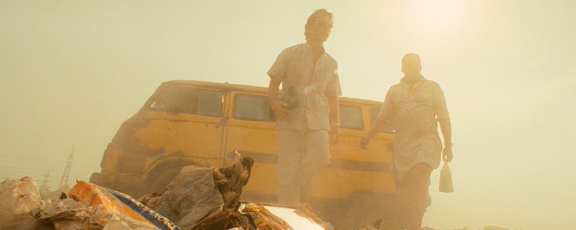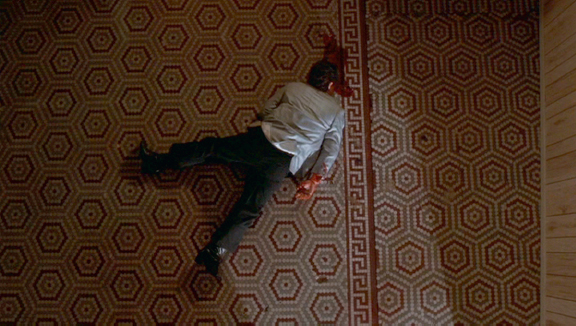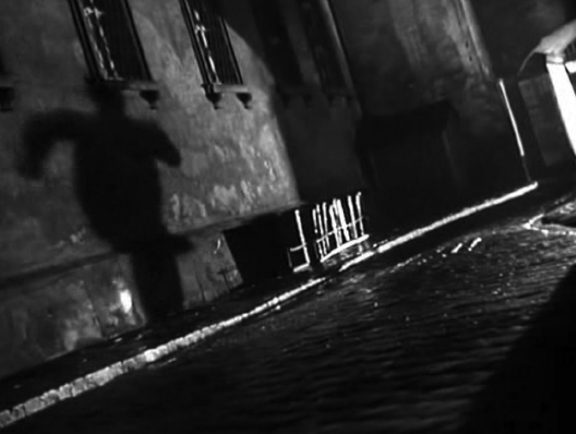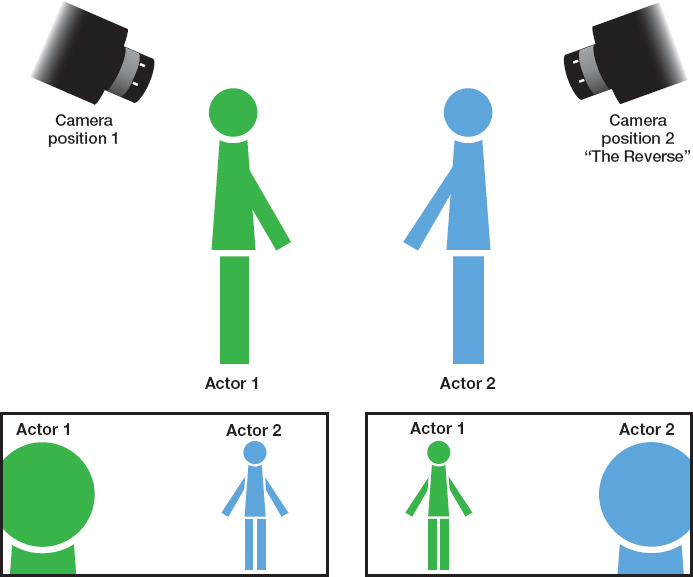Camera Angles: How You View the Scene
You’ve just learned a series of basic shots, each of which is an example of what the camera sees. When you decide the angle of each shot, you determine the viewpoint from which the camera shows the scene to the audience. Each camera angle, or viewpoint, is part of your visual language that tells the audience about the characters, their story, and the emotion of the scene. Following are the 10 most important shots associated with specific camera angles:
 Low-angle shot. A low-angle shot is one in which the camera is placed below the characters’ eye level. In this shot, the camera must be angled to look up to see the action. This gives the appearance of characters looming over the camera and puts them in a position of power. You might choose to shoot dangerous characters from a low angle to emphasize how menacing they are.
Low-angle shot. A low-angle shot is one in which the camera is placed below the characters’ eye level. In this shot, the camera must be angled to look up to see the action. This gives the appearance of characters looming over the camera and puts them in a position of power. You might choose to shoot dangerous characters from a low angle to emphasize how menacing they are.

LOW-angle shot in Slumdog Millionaire (2008)
 High-angle shot. A high-angle shot is one in which the camera is placed above the characters’ eye level. In this shot, the camera looks down on the action, often putting a character in a meek or powerless position. High-angle shots can also suggest objectivity and scale by placing the characters in the context of their surroundings.
High-angle shot. A high-angle shot is one in which the camera is placed above the characters’ eye level. In this shot, the camera looks down on the action, often putting a character in a meek or powerless position. High-angle shots can also suggest objectivity and scale by placing the characters in the context of their surroundings. Eye-level shot. In eye-level shots, the camera is placed at eye level with the actors, usually between five and six feet for adult actors. An eye-level shot does not draw attention to itself and conveys the action in a natural, objective fashion; it suggests that the audience, as an outsider, is observing the scene. When using eye-level shots, choose between close (tight) or far (loose) eyelines. A close versus far eyeline refers to how close an actor faces toward the lens while looking at an off-camera subject. An actor with a close eyeline looks very close to the lens, as if the off-camera subject were right next to the camera. An actor with a far eyeline looks well away from the lens, as if the subject were far away from the camera.
Eye-level shot. In eye-level shots, the camera is placed at eye level with the actors, usually between five and six feet for adult actors. An eye-level shot does not draw attention to itself and conveys the action in a natural, objective fashion; it suggests that the audience, as an outsider, is observing the scene. When using eye-level shots, choose between close (tight) or far (loose) eyelines. A close versus far eyeline refers to how close an actor faces toward the lens while looking at an off-camera subject. An actor with a close eyeline looks very close to the lens, as if the off-camera subject were right next to the camera. An actor with a far eyeline looks well away from the lens, as if the subject were far away from the camera. Bird’s-eye view. Also referred to as the overhead shot, the bird’s-eye view is shot above the action and looks straight down on it, from a very high angle. It makes the characters appear insignificant in the context of their surroundings.
Bird’s-eye view. Also referred to as the overhead shot, the bird’s-eye view is shot above the action and looks straight down on it, from a very high angle. It makes the characters appear insignificant in the context of their surroundings.

Bird’s-eye view (overhead) shot in Goodfellas (1990)
 Dutch angle. Usually the camera is placed parallel to the ground or horizon line; however, the Dutch angle, also called the oblique or canted shot, tilts this view and places the camera at an oblique angle to the horizon—now the images are on a diagonal. Dutch angles suggest instability, danger, strangeness, and suspense. You’ll often find them used in horror and suspense films or in a sequence in which a character experiences a physical or psychological change—as when a character is intoxicated or having an emotional breakdown. A classic film that uses Dutch angles to great effect is The Third Man (1949). (See Action Steps: Low-Budget Dutch Angle Trick, below.)
Dutch angle. Usually the camera is placed parallel to the ground or horizon line; however, the Dutch angle, also called the oblique or canted shot, tilts this view and places the camera at an oblique angle to the horizon—now the images are on a diagonal. Dutch angles suggest instability, danger, strangeness, and suspense. You’ll often find them used in horror and suspense films or in a sequence in which a character experiences a physical or psychological change—as when a character is intoxicated or having an emotional breakdown. A classic film that uses Dutch angles to great effect is The Third Man (1949). (See Action Steps: Low-Budget Dutch Angle Trick, below.)

Dutch angle in The Third Man (1949)
ACTION STEPS
Low-Budget Dutch Angle Trick
You don’t need fancy equipment to get a professional-looking Dutch angle—you just need the camera and your tripod.
 Remove the base plate from the tripod and install it on your camera at a 90-degree angle.
Remove the base plate from the tripod and install it on your camera at a 90-degree angle. Tighten it firmly, and then slide the camera onto your tripod.
Tighten it firmly, and then slide the camera onto your tripod. You can use the tripod’s tilt lever to create a Dutch angle.
You can use the tripod’s tilt lever to create a Dutch angle.
 USE POV CORRECTLY
USE POV CORRECTLY
Point-of-view shots must be taken from the perspective of the character whose point of view it is. If you start with a character’s POV shot at a wider angle and then move in closer, it tells the audience that the character is observing a detail or noticing something important, or that the filmmaker is emphasizing something.
 Point-of-view shot. A point-of-view (POV) shot shows what the actor is seeing during the scene. It is often shot with a handheld camera to give a sense of movement that mimics the way a character might be looking at something. POV shots are subjective and must be from the eye level of the character whose point of view it is. POV shots draw the audience into the action and into the mental and emotional state of the characters. They’re especially effective in suspense sequences, when a character is looking around corners for possible danger; in dialogue sequences, to “get inside the heads” of the characters as they listen and react to one another; and as inserts and cutaways, to reveal what a character sees or discovers. In the example of the insert shot of the gun (see here), you could shoot the same insert with a handheld camera from the subjective angle of another character; in this way, you’d communicate that the character has spotted the gun.
Point-of-view shot. A point-of-view (POV) shot shows what the actor is seeing during the scene. It is often shot with a handheld camera to give a sense of movement that mimics the way a character might be looking at something. POV shots are subjective and must be from the eye level of the character whose point of view it is. POV shots draw the audience into the action and into the mental and emotional state of the characters. They’re especially effective in suspense sequences, when a character is looking around corners for possible danger; in dialogue sequences, to “get inside the heads” of the characters as they listen and react to one another; and as inserts and cutaways, to reveal what a character sees or discovers. In the example of the insert shot of the gun (see here), you could shoot the same insert with a handheld camera from the subjective angle of another character; in this way, you’d communicate that the character has spotted the gun.
FIGURE 7.1Diagram of a reverse shot

 Over-the-shoulder. The over-the-shoulder (OTS) is an extremely common shot that includes two actors engaged in dialogue. The actor nearest the camera is called the foreground, or downstage, actor; this actor’s back will be to the camera (his or her face will not be visible), and the shot will include the actor’s shoulder. The actor who is facing the camera (and who is the main subject of the shot) is called the upstage actor and is framed in a medium or loose close-up shot. The OTS is an important shot because it can help establish the relationship (both physical and emotional) between two characters by linking them in a single shot. Use OTS for two-person dialogue scenes; just make sure to shoot both sides (over the shoulder of each actor). When you shoot OTS Actor A toward Actor B, then turn around to shoot OTS Actor B toward Actor A, it’s called a reverse shot, as seen in Figure 7.1. (See also Action Steps: Dirty vs. Clean, below.)
Over-the-shoulder. The over-the-shoulder (OTS) is an extremely common shot that includes two actors engaged in dialogue. The actor nearest the camera is called the foreground, or downstage, actor; this actor’s back will be to the camera (his or her face will not be visible), and the shot will include the actor’s shoulder. The actor who is facing the camera (and who is the main subject of the shot) is called the upstage actor and is framed in a medium or loose close-up shot. The OTS is an important shot because it can help establish the relationship (both physical and emotional) between two characters by linking them in a single shot. Use OTS for two-person dialogue scenes; just make sure to shoot both sides (over the shoulder of each actor). When you shoot OTS Actor A toward Actor B, then turn around to shoot OTS Actor B toward Actor A, it’s called a reverse shot, as seen in Figure 7.1. (See also Action Steps: Dirty vs. Clean, below.) Wide lens close-up vs. long lens (telephoto) close-up. You can shoot a close-up with different lenses, and the lens choice can make a dramatic difference. A wide lens close-up “stretches” the actor’s features and exaggerates the distance between the actor and the background. In visual language, this allows the camera to be close on the actor and still emphasize a sense of aloneness or isolation. The long lens close-up compresses the actor’s facial features and brings the background closer.
Wide lens close-up vs. long lens (telephoto) close-up. You can shoot a close-up with different lenses, and the lens choice can make a dramatic difference. A wide lens close-up “stretches” the actor’s features and exaggerates the distance between the actor and the background. In visual language, this allows the camera to be close on the actor and still emphasize a sense of aloneness or isolation. The long lens close-up compresses the actor’s facial features and brings the background closer. Profile shot. A profile shot can be a close-up or a wide shot—what’s important is profile image, which conveys the intensity of the actor’s gaze or the sculptural quality of the actor’s face. You set up a profile shot by making sure that the actor’s eyeline (the actor’s look direction to the off-camera subject) is at a 90-degree angle to the lens.
Profile shot. A profile shot can be a close-up or a wide shot—what’s important is profile image, which conveys the intensity of the actor’s gaze or the sculptural quality of the actor’s face. You set up a profile shot by making sure that the actor’s eyeline (the actor’s look direction to the off-camera subject) is at a 90-degree angle to the lens. Three-quarter back shot. This shot views the actor from nearly behind; however, the camera will still see part of the actor’s eyebrow and ear. (When an actor wears glasses, the shot will often focus on the frames.) The three-quarter back shot often conveys that an actor is deep in thought. As with the profile shot, this shot can be a close-up or a wide shot.
Three-quarter back shot. This shot views the actor from nearly behind; however, the camera will still see part of the actor’s eyebrow and ear. (When an actor wears glasses, the shot will often focus on the frames.) The three-quarter back shot often conveys that an actor is deep in thought. As with the profile shot, this shot can be a close-up or a wide shot.
 OBJECTIVE AND SUBJECTIVE SCENE WORK
OBJECTIVE AND SUBJECTIVE SCENE WORK
Using a one- to two-page, two-person scene as material, shoot it two ways: first, in a single shot in which both actors are in the frame; second, with POV shots from the position of each of the actors. The first version is an objective view of the scene, whereas the second version is a subjective view of the scene. Play back the footage and observe how the scene’s meaning is altered. What does each variation convey? Decide which angle (objective or subjective) best tells the story and emotion of the scene you’ve selected.
ACTION STEPS
Dirty vs. Clean
A medium or close-up shot that includes a foreground actor, such as an over-the-shoulder, is called dirty. A shot that does not include any other actor in the frame is called a clean shot. How do you shoot them, and when would you want the shot to be dirty or clean?
 For a dirty shot, focus on the main actor, and include some of the other actor’s face or body in the shot (enough so it’s clear that the second actor is making the shot “dirty”). This shot emphasizes the emotional or spatial relationship between the two characters.
For a dirty shot, focus on the main actor, and include some of the other actor’s face or body in the shot (enough so it’s clear that the second actor is making the shot “dirty”). This shot emphasizes the emotional or spatial relationship between the two characters. For a clean shot, isolate the main actor. No one else should be visible in the frame. This shot emphasizes only the main actor.
For a clean shot, isolate the main actor. No one else should be visible in the frame. This shot emphasizes only the main actor. Pro camera move: go from dirty to clean in one shot. This move starts with a dirty shot, then pushes in to the main actor until the shot is clean. Use this move when you want to show that something important is happening to the main character—for example, a moment of revelation, an emotional change, or a glimpse of recognition.
Pro camera move: go from dirty to clean in one shot. This move starts with a dirty shot, then pushes in to the main actor until the shot is clean. Use this move when you want to show that something important is happening to the main character—for example, a moment of revelation, an emotional change, or a glimpse of recognition.